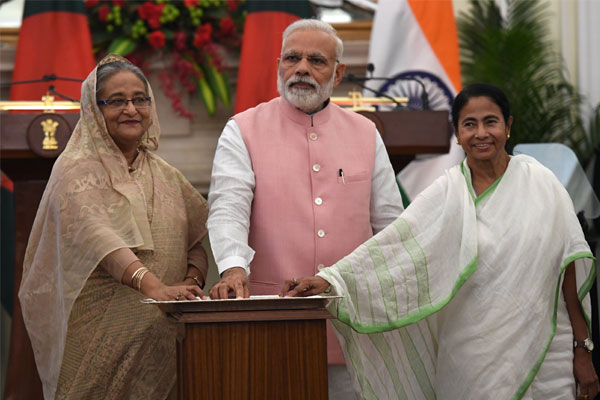
Bangladesh holds a premier position in India’s neighbourhood first policy as it heads the list of friendly neighbours after Bhutan. External Affairs Minister Sushma Swaraj’s visit to Dhaka last week was to co-chair the fourth Indo-Bangladesh Joint Consultative Committee meeting and to build on the decisions taken during Bangladesh Prime Minister Sheikh Hasina’s visit to India in April this year. But the Rohingya crisis that Bangladesh faces with the influx of over 600,000 refugees from Myanmar’s Rakhine state became one of the main topics of discussion during the visit.
India-Bangladesh ties have been on a steady upswing in the past years, with both sides making efforts to resolve long pending issues that have ranged from the land boundary agreement to supply of electric power to Bangladesh and granting transit access to India’s northeastern states through Bangladeshi territory. A regular exchange of high level visits helps to take the ties forward and remove any impediments that have cropped up in the relations. Bangladesh Foreign Minister AH Mahmoud Ali was in Delhi in April while Finance Minister Arun Jaitley visited Dhaka earlier this month.
Swaraj took the opportunity to reiterate India’s support to Bangladesh government on its handling of the Rohingya crisis. Dhaka had sharply resented India’s lukewarm response to Rohingya crisis and Banglad-eshi leaders and officials had openly expressed their dismay at New Delhi’s position.
India tried to make amends by clarifying its position and sending a consignment of relief material and essential supplies for the Rohingya refugees in Bangladesh. Swaraj also had a discussion with Sheikh Hasina on the air flight while the two leaders were returning home in September from the UN General Assembly session in New York.
India’s initial stance on Rohingya crisis had supported Myanmar government; it had dwelt mainly on the attacks on Myanmar security posts and military camp by Rohingya militants and was articulated during Prime Minister Narendra Modi’s visit to Myanmar. This was just as retaliatory violence had led to the beginnings of the massive exodus of Rohingyas refugees to Bangladesh. The Modi government had also indicated its plans to deport Rohingya refugees from India, accusing them of having links with international jihadi groups.
In Dhaka, Sushma Swaraj said that India was deeply concerned at the spate of violence in Rakhine state. “We have urged that the situation be handled with restraint, keeping in mind the welfare of the population. In our view, the only long-term solution to the situation in Rakhine state is rapid socio-economic and infrastructure development that would have a positive impact on all communities living in the state.” India supports the implementation of the recommendations Kofi Annan commission’s report, she said, adding that India favoured the return of the refugees to Myanmar.
The External Affairs Minister also launched 15 new Indian assisted projects worth about $8.7 million during her two-day visit. India has increased its line of credit for Bangladesh to $8 billion, the highest level of Indian development assistance offered to any country. But there is an impression in some sections in Dhaka that some of the high profile Indian projects have brought little benefits to Bangladesh.
The new land access route through Bangladeshi territory was expected to open up greater economic opportunities in Banglad-esh, but has failed to live up to that promise. Two years after the bus route from Kolkata through Bangla-desh to Agartala in Tripura was opened, there are few travellers on the route.
The river route with transshipment through Ashuganj river port for Indian cargo has also largely fallen into disuse as rail connectivity has improved with the broad gauge conversion on the Agartala-Guwahati line. The high transit fees and lengthy transit procedures make the inland water route unattractive to transporters. Both high profile transit projects require improved infrastructure to make them viable. The bus route with its multiple entry visas and immigration formalities at two points takes almost 30 hours with an overnight halt in Dhaka and does not compare favourably with the Kolkata-Siliguri route. However, 24 smaller developmental projects have been implemented in the past three years and another 58 city development projects are currently underway.
People to people contacts and connections were the biggest strength in Indo-Bangladesh ties, Swaraj said, pointing out that improved ties had made Bangladesh the largest source of foreign travelers to India as 9.76 lakh visas were issued in 2016 to Bangladeshi visitors to India.
In an outreach to the wider political spectrum in Bangladesh, Swaraj called on Bangladesh National Party leader Begum Khaleda Zia and Begum Raushen Ershad of Jatiya Party, which is the official opposition in the Bangladesh National Assembly as BNP had boycotted the last election. She expressed the hope that forthcoming elections in 2018 would be fair and with participation of all political parties.



